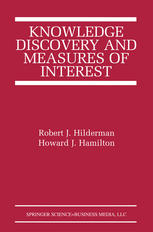

Most ebook files are in PDF format, so you can easily read them using various software such as Foxit Reader or directly on the Google Chrome browser.
Some ebook files are released by publishers in other formats such as .awz, .mobi, .epub, .fb2, etc. You may need to install specific software to read these formats on mobile/PC, such as Calibre.
Please read the tutorial at this link: https://ebookbell.com/faq
We offer FREE conversion to the popular formats you request; however, this may take some time. Therefore, right after payment, please email us, and we will try to provide the service as quickly as possible.
For some exceptional file formats or broken links (if any), please refrain from opening any disputes. Instead, email us first, and we will try to assist within a maximum of 6 hours.
EbookBell Team

4.8
64 reviewsKnowledge Discovery and Measures of Interest is a reference book for knowledge discovery researchers, practitioners, and students. The knowledge discovery researcher will find that the material provides a theoretical foundation for measures of interest in data mining applications where diversity measures are used to rank summaries generated from databases. The knowledge discovery practitioner will find solid empirical evidence on which to base decisions regarding the choice of measures in data mining applications. The knowledge discovery student in a senior undergraduate or graduate course in databases and data mining will find the book is a good introduction to the concepts and techniques of measures of interest.
In Knowledge Discovery and Measures of Interest, we study two closely related steps in any knowledge discovery system: the generation of discovered knowledge; and the interpretation and evaluation of discovered knowledge. In the generation step, we study data summarization, where a single dataset can be generalized in many different ways and to many different levels of granularity according to domain generalization graphs. In the interpretation and evaluation step, we study diversity measures as heuristics for ranking the interestingness of the summaries generated.
The objective of this work is to introduce and evaluate a technique for ranking the interestingness of discovered patterns in data. It consists of four primary goals: